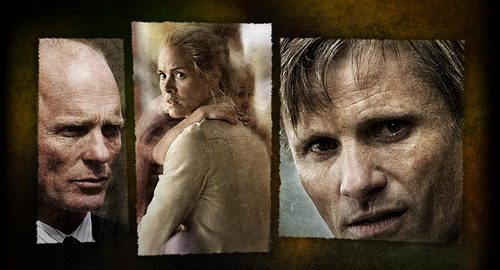Anomalous superficiality
Thu. October 20, 2005Categories: Abstract Dynamics

Hey! Old skool-style inter-blog bizniz; Jodi answers my objections to her reading of A History of Violence and now Steven Shaviro weighs in with what may turn out to be the definitive account.
Jodi complains that I have failed to take account of her acknowledgement that the Gangster elements of the film are no less real than the Family scenes. On the contrary, I think that it is her reading which contradicts that acknowledgement, and must do. I accept that, explicitly, she concedes that the Family reality has no ontological priority over the Gangster. But the point is that her interpretation of the film depends upon a clear implication inconsistent with that awareness. To say that the film is the son, Jack’s, fantasy is, surely, to say that the entire Gangster plot is the product of his psychological conflicts. How could this not be treating Jack – and by extension the Family/ melodrama generic elements – as more ‘basic’, i.e. more real, than the Gangster generic elements? On this model, Jack’s psychology is a stablizing epistemological baseline to which everything in the film can be indexed. Yet there seems to me to be no warrant in the film for such a privileging. On the contrary, what is remarkable about A History of Violence is its refusal of the possibility of this kind of hierarchical settling. Jack’s psychological conflicts and ‘struggles with manhood’ are every bit as cliched as the hyperbolic violence of the Joey plot. To treat the Melodrama conventions as generative of the Gangster conventions is not only arbitrary, it misses what is most troubling, and most distinctive, about the film’s ontological disturbances, which amount to a kind of Escherizing of genre.
A History of Violence is characterized by what we might call an anomalous superficiality. The film is pure surface, or rather, pure surfaces, limned together in such a way that we are aware of a structural inconsistency but are unable to ‘see the joins’. The seamlessness of which I wrote in my last post is the seamlessness of the moebian band, about which Steven writes so well:
‘At any given point, it seems to have two sides; but the two sides are really the same side, each is continuous with the other, and slides imperceptibly into the other. There is no way to separate the Capra/Spielberg side from the noir/revenge nocturnal side. The common interpretive tendency in cases like this is to see the dark side as the deep, hidden underside of the bright side, the depths beneath the seemingly cheerful surface. But in A History of Violence, everything is what it seems. Both sides, both identities, are surfaces; both are superficial; and they blends into one other almost without our noticing. The small town, with its overly ostentatious friendliness, is a vision of the good life; but brother Richies enormous mansion, furnished with a nouveau-riche vulgarity that almost recalls Donald Trumps penthouse, is also a vision of the good life.’
An important point here being that Trump’s own penthouse – in ‘real life’ – is itself, of course, a fantasy, but so is small town family life. It, too, is a matter of actors occupying a stage-set. America, as Baudrillard, following Dick and Ballard, long ago realised is itself, in its ‘actual reality’, an assemblage of incommensurable ‘reality options’ given an illusory but performatively effective consistency only by fantasy. Yet fantasy precisely has no origin in interiority; on the contrary, all seeming interiority is the playing out of fantasies that are intrinsically social. Furthermore, it is not only that, as Steven rightly insists, cinematic fantasies are social; it is also that social fantasies are now deeply cinematic.
Hence to see the film as the playing out of our fantasies is at the same time to see ourselves as the playing out of fantasies which belong to no-one, which cannot be routed in any Inside. Jodi is right that this is to void any interpretation confined to the film’s ‘content’. Again, though, this is the point. For psychological interpretations not only privilege a particular psychology within the diegesis; they also privilege the epistemological over the ontological. A History of Violence, however, is a film which goes out of its way to expose the way in which genre is ontology, and demands that we pose to ourselves the question of our libidinal complicity in the realities cinema constructs. It is a film which invites us to confront the radical inconsistency of ‘our’ fantasmatic constructions and of our libidinal investments. Our desire for the family idyll is what produces our cheering for Jack and Tom’s recourse to ultraviolence when that idyll is threatened, and this complicity is the ‘glue’ which joins the two ‘sides’ of the moebian band – the Capra/ Spielberg and the noir/ revenge worlds – together in a seamless loop. A film reduced to Jack’s psychological conflicts could safely be externalized, but if we ourselves are Tom-Joey – animals with a taste for violence hiding in a simulation of domesticity – then the film has forced us to confront the flimsiness of the film sets we inhabit. A History of Violence would then belong to a kind of meta-generic ontological uncanny which performs that destruction of the homely that the Situationists were so fond of invoking.
‘The show is over. The audience get up to leave their seats. Time to collect their coats and go home. They turn around
no more coats and no more home.’ Vasily Vasileyevich Rozanov, The Apocalypse of Our Time